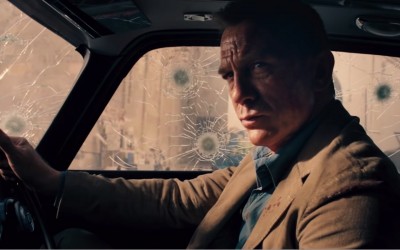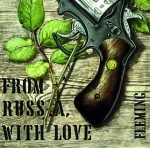
(Warning: Spoilers Ahead). There have been a number of comments from critics and Bond fans alike that the ending to the new James Bond movie, No Time To Die, is somehow not in the ‘Fleming tradition’ and is ‘unBond-like’.
Some people have been quite shocked at EON’s decision to go for what appears to be such a risky, if bold, conclusion to the Daniel Craig cycle of James Bond movies.
It has been compared to the downbeat ending to On Her Majesty’s Secret Service, where director Peter Hunt took the brave decision to follow Ian Fleming’s book very closely, and have a concluding scene that sees Bond’s new wife Tracy brutally slain by Irma Bunt and Ernst Stavro Blofeld. Instead of the traditional upbeat, often lighthearted, ending that had come to characterise the Sean Connery 007 films, George Lazenby’s one-off adventure as Bond left audiences quite stunned and subdued. The producers studiously avoided having such an ending until, arguably, the Daniel Craig cycle of films, with their emphasis on gritty human drama and authenticity.
In this sense, we should not really be surprised about the ending to No Time To Die. From Craig’s perspective, it is a satisfactory conclusion to his five adventures as Ian Fleming’s spy, and clearly signals his departure is final and irreversible (unless, of course, he is somehow lured back with a Connery-scale deal of the type given to the late actor for Diamonds Are Forever. But Craig himself has firmly rejected such a possibility).
The Facts of Death

We also need to remind ourselves that, far from being something ‘non-Fleming’, the presence of death has, in many ways, been at the very heart of the Bond novels and also the EON film franchise. In fact, despite the claims of some people that Bond should ‘never die’, James Bond has died before: author Ian Fleming, during the writing of his fifth Bond novel From Russia, With Love (1957), had become rather tired of his famous creation and felt notably ambivalent about his future (he wrote to his close friend William Plomer that he feared ‘staleness’ and ‘waning enthusiasm’ for ‘this cardboard booby’), so he decided (controversially) to kill Bond off. At the end of the novel, Bond crashed to the floor, poisoned by the evil Rosa Klebb. This nearly marked the end of the series, but Fleming seems to have changed his mind after being urged by other friends to not kill off this golden goose.
Moreover, after working on material for a proposed James Bond TV series, a project which collapsed, Fleming found he suddenly had some material that he could easily take and convert into a new 007 novel. One plot scenario he had developed for a TV episode thus became the storyline for Dr. No (1958).
And, as all good Bond aficianos will know, the sixth James Bond novel revealed that Bond was not dead: he was now recovering (in ‘convalescence’) from the near-lethal kick from Klebb described in the previous novel. Bond was well and truly back, much to the relief of Fleming’s growing army of fans.
Live and Let Bond
In many ways, a morbid fascination with death, and the very many ways to die, was at the very heart of Ian Fleming’s novels and short stories. Even some of the titles appear to have been chosen by Fleming to reflect this, perhaps with his tongue firmly in his cheek at times: Live and Let Die, From a View to a Kill, You Only Live Twice, and so on. John Gardner, who penned a series of Bond novels and stories, also seems to have recognised the value of ‘death’ in the titles of his Bond adventures, as did Raymond Benson.
Added to this, in a delicious irony, one of the Bond producers, Albert ‘Cubby’ Broccoli, also had a background in the ‘death industry’ – one of his first jobs was working for the Long Island Casket Company in New York, and he got to know all of the city’s leading undertakers and key Funeral Directors. He recalled in his memoirs how used he became to walking into mortician’s parlours without blinking an eye.
Clearly, some of this went into the early Bond movies. And, in another coincidental irony, the actor who became EON’s first James Bond, Sean Connery, had himself worked at one point polishing coffins.
In fact, when you think about it, when combined with some of the ‘death’ elements of Fleming’s novels, quite a few ‘death’ in-jokes appeared in the early Bond movies (a doomed hearse in Dr. No, whose occupants also met their death, enabled Connery’s Bond to make a great quip to draw a laugh from the cinema audience), and this ‘tradition’ continued: Connery’s Bond ‘died’ in You Only Live Twice and was nearly cremated in Diamonds Are Forever, while the diamonds being transferred to America in DAF were stashed in a corpse in a metal casket! References to death even became part of the marketing of the movies (‘And twice is the only way to live’). Similarly, the Roger Moore movies continued with such ‘death’ in-jokes: who can forget the jazz funerals in Live and Let Die and the Baron Samedi voodoo themes, or the attempt on Bond’s life in Venice made by a knife-wielding ‘corpse’ who rises from a casket in Moonraker? The comedian Alfie Bass at one point in Moonraker also does a kind of double-take when he spots a coffin floating in the canal.

James Bond himself also appears to be a regular attendee at funerals: think Thunderball, The World Is Not Enough or Spectre, and he evidently likes to visit graves in churchyards or cemeteries: think For Your Eyes Only or No Time To Die. Director Sam Mendes, in a kind of homage to Roger Moore’s 007 debut Live and Let Die, even had Craig’s 007 dressed as a top-hatted skeleton at the famous Mexican ‘Day of the Dead’ festival in the thrilling pre-credits to Spectre.
The Bond films generally have also been noted for the numerous deaths and serious injuries that have littered their storylines, ranging from the various villains and their side-kicks dying in all sorts of imaginative and spectacular ways to the many extras who seem so easily expendable (especially when Bond is involved in major shoot-outs using a machine-gun, such as in Tomorrow Never Dies, something that pops up again in No Time To Die). And we love it!
The point is, ‘death’ in all its forms was, in many ways, an essential ingredient in Ian Fleming’s original stories, and this was echoed strongly in the 24 EON films made prior to No Time To Die. Bond has many times faced death, and the films have often toyed with the audience, inviting them to decide how he will survive or whether it really is curtains for our James. There is a key moment early on in No Time To Die when Bond is in his Aston Martin DB5, with Madeleine Swann sitting next to him, and they are surrounded by men firing mercilessly at the Aston’s bodywork and windows. The car’s windows have clearly been made from reinforced bullet-proof glass, but there comes a point where it seems even they are buckling under the intensity of the gunfire. Bond merely sits there, angry with Madeleine but unflinching and unmoved by the gunfire, much to Madeliene’s eventual distress. It is as if James Bond is deliberately looking death in the face, daring it to take him. It’s a telling moment, full of tension.
But Bond regularly has death for breakfast. It’s all part of the escapist fun. And, far from being outside the Fleming ‘tradition’ or going against the grain of the EON films, the ‘death’ of Craig’s Bond in the climax to the 25th 007 adventure (whether you like it or loathe it) sits quite comfortably with what has gone before.
Many members of the public have, of course, been taken by surprise by the dramatic climax to No Time To Die, and the director and producers have, in some ways, taken a very brave gamble with having such an ending, especially one which packs such an emotional punch. However, as all Bond fans will know, and anybody even vaguely familiar with the Bond universe will also know, while Craig’s Bond may be ‘dead’, James Bond (we can confidently predict) will live to fight another day. Rest assured.

James Bond waits at the Slumber Funeral Home in Las Vegas (Diamonds Are Forever)
